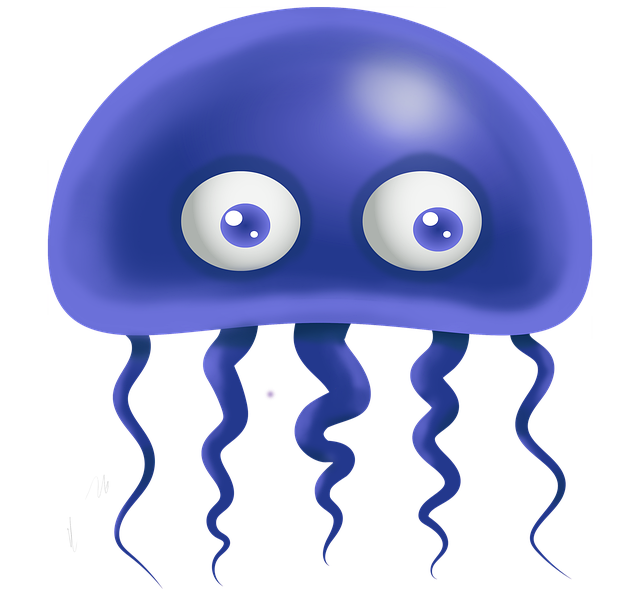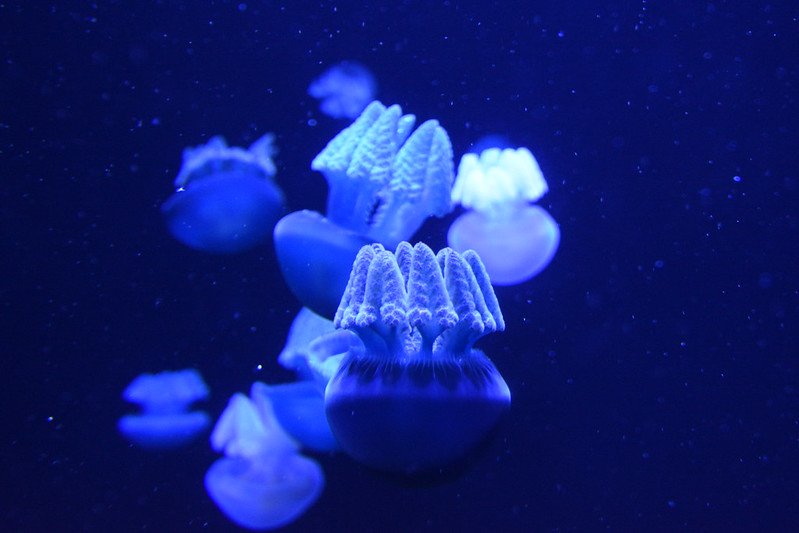What secrets lie within their graceful movements and azure hues? Let’s dive into the ocean to discover the wonders of the Blue Blubber Jellyfish. We’ll learn about its beauty and role in the underwater world.
Key Takeaways:
- The Blue Blubber Jellyfish, known scientifically as Catostylus mosaicus, is a popular jellyfish species of the sea.
- They stand out with a dome-shaped bell and vary in color from light blues to dark purples.
- As active swimmers, you can often see them in aquariums.
- They live up to a year and don’t sting, making them safe pets.
- Blue Blubber Jellyfish get along well with other species like the Red Cross Blubber Jellyfish in tanks.
Blue Blubber Jellyfish Size and Lifespan
Blue Blubber Jellyfish, known as Catostylus mosaicus, start small. They are about the size of a young child’s fist when purchased. As they grow, they can reach up to 10cm (4 inches) in size.
They don’t live very long once in a tank, just up to a year. You really have to watch over them to keep them healthy during their brief life. This requires paying close attention to their care.
| Species | Size | Lifespan |
|---|---|---|
| Blue Blubber Jellyfish | Up to 10cm (4 inches) | Up to 1 year |
The table shows how big they can get and how long they might live. About 10cm (4 inches) is their size limit, with a maximum lifespan of a year. But remember, this is under the best care conditions
Jellyfish Growth and Development
Blue Blubber Jellyfish have an interesting lifecycle. They grow from tiny juveniles to adults over time. Their colors and patterns change, making them even more captivating. Watching them can be a wonderful aquarium hobby.
Blue Blubber Jellyfish Care and Compatibility
Blue Blubber Jellyfish need carefully set up tanks. They thrive in water that’s between 24-28°C. This is vital for their health in your tank.
Feeding them is easy. Give them baby brine shrimp or frozen copepods once or twice a day. Mixing in some jellyfish food is smart. It fills in any nutrient gaps they might have.
Making the right tank environment is key for Blue Blubber Jellyfish. They do well in tanks with some water movement. This stops them from getting hurt by bumping into the walls. Remember, they love to swim freely with nothing in their way.
Blue Blubbers can live well with others, like Red Cross Blubbers, too. Having more than one jellyfish type can make your tank look amazing. But, always watch how they get along to avoid fights or stress.
With the right care, food, and tank, Blue Blubbers can do great in your tank. They’ll not only be healthy but also charming and unique in your aquarium.
| Blue Blubber Jellyfish Care and Compatibility | |
|---|---|
| Water Temperature | 24-28°C |
| Feeding | Baby brine shrimp Frozen baby brine shrimp Frozen copepods Specialized jellyfish food |
| Tank Requirements | Medium to fast water flow Avoid obstructions Ensure ample space |
| Compatibility | Red Cross Blubber Jellyfish Monitor behavior |
| Note: It’s crucial to research and understand the specific care needs of all jellyfish species before keeping them together. |
Blue Blubber Jellyfish Habitat and Distribution
The Blue Blubber Jellyfish, known as Catostylus mosaicus, is found across the east coast of Australia. These jellyfish live in harbors, estuaries, and open waters. They live in places like the Great Barrier Reef and around Sydney and Brisbane. They prefer waters less than 30 meters deep.
This jellyfish can handle different levels of salt in the water. This makes them able to live in many coastal places. They often gather in large groups, making stunning displays in the ocean.
Blue Blubber Jellyfish are at home in the eastern Australian seas. Their environment gives them plenty of food and keeps them safe from enemies. They eat tiny plankton animals with their special stinging cells.
The following table gives a short overview of their habitat and where they are found:
| Habitat | Distribution |
|---|---|
| Harbors | East coast of Australia |
| Estuaries | Great Barrier Reef |
| Open water | Moreton Bay |
The Blue Blubber Jellyfish shows how adaptable and strong sea life can be. Their presence in Australia’s waters adds to the area’s diverse marine life.
Blue Blubber Jellyfish Feeding and Diet
The Blue Blubber Jellyfish, also known as Catostylus mosaicus, eats larvae and small crustaceans. It has special cells called nematocysts for catching food. These cells have toxins that stun the food, making it easy for the jellyfish to eat.
This jellyfish is unique because it has club-shaped oral arms with lots of mouths. These arms help catch the food, then pass it to the many mouths. The food goes from there to the jellyfish’s stomachs.
These jellyfish mainly eat zooplankton like small shrimp and copepods. These small creatures are a huge source of energy for the jellyfish. Providing different kinds of food is very important for them to stay healthy and grow well.
Feeding Blue Blubber Jellyfish a mix of zooplankton is crucial for their health. They need this variety to get all the necessary nutrients. A varied diet helps them stay colorful and full of life.
“Proper nutrition is key to keeping Blue Blubber Jellyfish healthy and thriving. By providing a varied diet of zooplankton, jellyfish keepers can ensure their jellyfish are getting the necessary nutrition to flourish.”
Sample Feeding Schedule:
- Feed Blue Blubber Jellyfish small shrimp twice a day.
- Offer frozen copepods to supplement their diet every other day.
Comparison of Blue Blubber Jellyfish Feeding Requirements
| Food Type | Frequency |
|---|---|
| Small Shrimp (baby brine shrimp) | Twice a day |
| Frozen Copepods | Every other day |
Blue Blubber Jellyfish Behavior and Adaptations
Blue Blubber Jellyfish are special because of how they act and survive in the sea. Their shape helps them drift easily in the water. They have a special way of swimming, moving smoothly up and down.
When they swim, these jellyfish sometimes travel with fish or copepods. These small creatures eat the jellyfish’s mucus. This food keeps them healthy.
Even though they are gentle, the jellyfish have small stinging cells in their tentacles. This can make human skin itch if it touches them. But they are not very dangerous to people.
Let’s take a closer look at how Blue Blubber Jellyfish behave and adapt:
Swimming Adaptation
They swim by pulsing their bell. This motion helps them move up and down in the water. It lets them see the world around them and find food.
Association with Fish and Copepods
They attract fish or copepods with their mucus. This relationship helps both the jellyfish and these creatures. It’s a way they both win.
Nematocyst Defense Mechanism
The stinging cells in their tentacles protect them from harm. They also catch food with these cells. This keeps the jellyfish safe and well fed in the ocean.
Blue Blubber Jellyfish’s ways of swimming, making friends, and staying safe are amazing. They are interesting creatures to learn about.
| Behavior and Adaptation | Description |
|---|---|
| Swimming Adaptation | The pulsing motion of the bell allows efficient movement through the water. |
| Association with Fish and Copepods | Other species benefit from consuming the mucus of the jellyfish. |
| Nematocyst Defense Mechanism | Specialized stinging cells provide protection and enable prey capture. |
Blue Blubber Jellyfish Interesting Facts
The Blue Blubber Jellyfish is from the Catostylus genus in the Cnidaria phylum. It’s often seen in the Indo-Pacific’s coastal areas. These jellyfish are known to easily thrive in tanks because they have a unique connection with algae.
Now, keeping Blue Blubber Jellyfish at home is not easy. These animals don’t live very long, making their care complex. They are best suited for people who are skilled in jellyfish care and keeping.
Blue Blubber Jellyfish Sting Treatment
If you get stung by a Blue Blubber Jellyfish, act fast to lessen the pain. It’s vital to tackle the sting right away to avoid more problems. Follow these key steps:
- Do not use freshwater or vinegar: Many think using freshwater or vinegar helps. But, they can make the sting hurt more. They cause more jellyfish cells to sting you again, leading to more pain.
- Avoid rubbing the sting: It might seem like rubbing is a way to reduce pain. But, it’s not a good idea. Rubbing can make the situation worse by spreading the venom.
- Apply hot water: Use hot water that’s not hot enough to burn you. Soak the sting area for about 20 minutes. This step fights the venom, lessening pain and itchiness.
- Use an ice pack: If you can’t get hot water, try an ice pack. Wrap it in a cloth and put it on the sting. It’ll help with swelling and make the sting area numb.
- Seek medical attention: If pain continues, if you have trouble breathing, or show signs of an allergic reaction, get help right away.
Stick to these steps for treating a Blue Blubber Jellyfish sting. They’ll help you deal with the discomfort. Always focus on being safe when enjoying water activities.
Conclusion
Blue blubber jellyfish are amazing marine life and can be attractive pets. They come in many colors and look unique. Yet, they need special care and food, so they are better for people who know about jellyfish.
Having them in an aquarium can be a very rewarding thing. It’s like having a beautiful, living piece of the ocean. Their beauty and behavior are something to see for anyone who loves sea life.
These jellyfish show us how incredible the ocean is and how everything is connected. Even though they live for only up to a year, they teach us a lot. By making the right home for them, we help keep them healthy and happy.
If you love jellyfish or want to start learning about sea creatures, think about getting some blue blubber jellyfish. Their colors and movements will make your aquarium look even better. They are a great way to show off the amazing life in the ocean.

